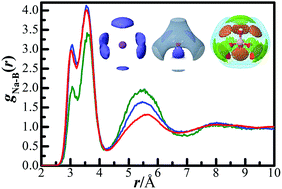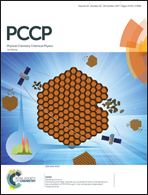B(OH)4− hydration and association in sodium metaborate solutions by X-ray diffraction and empirical potential structure refinement†
Abstract
X-ray diffraction is used to study the structure of aqueous sodium metaborate solutions at salt concentrations of 1, 3, and 5 (oversaturated) mol dm−3. The X-ray structure factors are subjected to empirical potential structure refinement (EPSR) modelling to extract the individual site–site pair correlation functions, the coordination numbers, and the spatial density functions (three-dimensional structure) of ion hydration and association as well as solvent water in the borate solutions. The sodium ion is surrounded on average by (5.4 ± 0.7), (4.6 ± 1.0), and (3.7 ± 1.2) water molecules at 1, 3, and 5 mol dm−3, respectively, with the Na–O (H2O) distance of 2.34 Å. The decrease in hydration number of the sodium ion is compensated by direct binding of the oxygen atom of the borate ion, B(OH)4−, with the average coordination number of (0.2 ± 0.5), (1.0 ± 0.8), and (2.1 ± 1.3) at the Na–O(B) distance of 2.34 Å to keep the octahedral hydration shell of the sodium ion. The average number of water molecules around the borate ion is (13.9 ± 1.8), (14.2 ± 1.8), and (16.1 ± 2.4) per borate ion with increasing salt concentration with the B–O(H2O) distance of 3.72 Å. The number of nearest-neighbour water molecules around a central water molecule in a solvent decreases as (4.8 ± 1.2), (3.8 ± 1.1), and (2.8 ± 1.1) with an increase in salt concentration with the O(H2O)–O(H2O) distance of 2.79 Å. The Na+–B(OH)4− ion association is characterized by the Na–O(B) and Na–B pair correlation functions. The Na–B interactions are observed at 3.00 Å as a shoulder and 3.57 Å as a main peak in the site–site pair correlation function, suggesting two occupancy sites of Na+ with one for the edge-shared bidentate bonding and the other for the corner-shared monodentate bonding. The total number of Na–B interactions at 3.00 and 3.57 Å is consistent with that of the Na–O(B) interactions. The detailed three-dimensional structure of the ion hydration and association is visualized as a function of salt concentration. The structure and stability of [NaB(OH)4(H2O)6]0 clusters are further investigated by DFT calculations, and the most likely structure is proposed and cross-checked.



 Please wait while we load your content...
Please wait while we load your content...